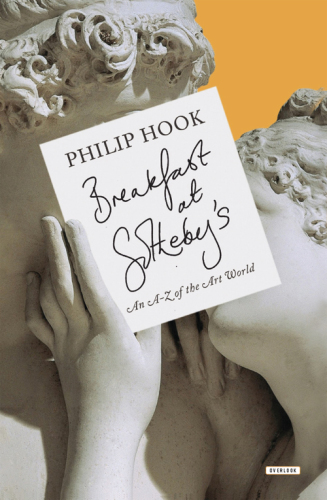
Breakfast at Sotheby's
An A-Z of the Art Word
کتاب های مرتبط
- اطلاعات
- نقد و بررسی
- دیدگاه کاربران
نقد و بررسی

July 14, 2014
Hook (The Ultimate Trophy), a director and senior paintings specialist at Sotheby’s and a former director at Christie’s, presents a witty guide to the contemporary art market. Although he is unquestionably a participant and a leader in these markets, he veers away from easy praise, preferring a tongue-in-cheek, wry voice that teases his milieu. Speaking of the lag in the English markets’ response to Impressionism, he asks: “Why should we give good money for something that didn’t take very long to knock up?” Organized alphabetically into five sections, the book is marked by the kind of breezy observations that allow for generally satisfying overviews, with few profound revelations. Readers with art world knowledge will find mostly familiar information. Similarly, while Hook is quick to poke fun, his selection of topics and artists reflect a status quo that itself seems outdated. His early section on female artists, for instance, notes the problematic gender imbalance in contemporary art, though the remaining pages talk almost exclusively about men. And even though today’s markets are heavily influenced by living artists, his chosen examples after the mid-20th century rarely venture further than Jeff Koons. Despite his limited focus, Hook is entertaining, and the anecdotes from his career are particularly lively. 82 b&w illus.

Starred review from August 15, 2014
Hook (The Ultimate Trophy: How the Impressionist Painting Conquered the World, 2009, etc.) uses his years of experience to explain why paintings succeed or fail.The author's tenure as former director of Christie's and his current role as director and senior paintings specialist at Sotheby's make his book a great reference, but his delightful British irreverence makes it fun to read. When considering works of art, the subject matter is paramount. Paintings of sport include images of stags, partridges, grouse, etc.-a kind of trophy art, literally painting what you kill. Certainly, depictions of pretty women are popular and are among the best sellers, though horizontal women are better than vertical, assuming she's pretty and not dead. On the other hand, a picture might not sell for any number of reasons-e.g., poor branding, bad provenance, adverse emotion or simply because there's no red in it. In an A-to-Z format, Hook discusses the effect of subjects as diverse as rain, interiors, nudes and railways, and his expertise extends from the impressionists forward, with insightful explanations of such 20th-century movements as surrealism and expressionism. The author really hits his stride when he shows how life events affect sales, especially if an artist suffered some horrendous loss or died early-sure selling points. He also lists a number of World War I artists whose work declined precipitously after the war, including Giacomo Balla, Juan Gris and Eric Heckel. Great for those who are spending millions to invest in art, this book will certainly help readers who keep hoping for a magical garage sale find. Hook surely saw a few of those in his 25 years on the original British Antiques Roadshow. A winner. Readers will learn more about the modern art market in this simple book than in any college course.
COPYRIGHT(2014) Kirkus Reviews, ALL RIGHTS RESERVED.

October 15, 2014
Hook has 35 years' experience working in the art world in various capacities, including as senior director of impressionist and modern art at Sotheby's and head of Christie's 19th Century Paintings Department. This guide to the value of artworks is organized into five sections according to viewers' questions about artists ("Who is it by?"); subjects and styles ("Do I like it?"); wall-power ("What will people think of me?"); provenance and more ("How much is it worth?"); and long-term market value ("How much will it be worth?"). Each of the sections is alphabetically arranged, with the author discussing Bohemianism, branding, individual artists, female artists, mental illness, -isms, animals in art, exoticism, emotional impact, fakes, framing, genius, restoration, restitution, theft, collectors, emerging markets, exhibitions, taxation, and many other topics. Brilliantly conceived in a reference format, this accessible, enjoyable, and insightful publication by an art expert can be read from cover to cover or consulted by topic. Authoritative but definitely not academic or comprehensive, it may serve as a helpful first guide to aesthetic, cultural, economic, and other factors that influence the valuation of artworks. VERDICT Highly recommended for art buyers, art lovers, dealers, and other professionals as well as for general readers hoping to gain an introduction to and further knowledge of the art market and art valuation. It belongs in many library collections, including those of public and special libraries.--Cheryl Ann Lajos, Free Lib. of Philadelphia
Copyright 2014 Library Journal, LLC Used with permission.

September 15, 2014
Hook offers up a dishy lexicon of art-world topics and terminology in this loosely structured dictionary. As painting specialist for Sotheby's auction house and a popular appraiser on Antiques Roadshow, Hook is fascinated by the relationship between art and money, and by the ways in which an artwork obtains its market value. Relying on 35 years of experience and anecdote, Hook divides his guide into sections that cover artists' backstories, artists' subjects, visual impact, provenance, and market variance. Each section contains a unique alphabet of pithy, bite-size essays, which lay bare outrageous episodes of art history and oddities of audience taste. Football, for example, charts auction sales against ballplayer salaries over time. Interiors reveals that Bonnard's bathrooms and Matisse's hotels are in demand, while no one wants paintings of churches. War (191418) cheerfully lists artists whose work would have fetched better prices if only they had perished earlier. With its tone of art-history-textbook-meets-tabloid, Hook's witty primer provides a truthful yet humorous crash course, an insider's take that is more gentle ribbing than art-world expos'.(Reprinted with permission of Booklist, copyright 2014, American Library Association.)

























دیدگاه کاربران